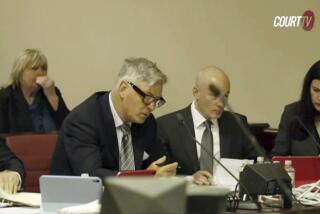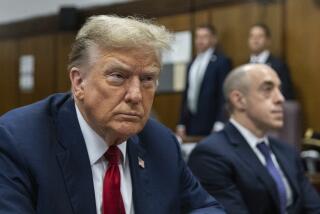Jurors Picked as Andersen Trial Gets Underway
- Share via
HOUSTON — Attorneys selected a federal jury Monday to determine whether accounting giant Arthur Andersen obstructed justice by shredding documents from its audit of Enron Corp. last year.
The selection of 12 jurors and four alternates came at the end of the first day of a trial that could determine the fate of the 89-year-old accounting firm. The case also marks a crucial opening move in the Justice Department’s broader investigation of the meltdown last year of Houston-based Enron.
Prosecutors and Andersen attorneys began unfolding their strategies during the selection process, defining the dimensions of the legal skirmishes that lie ahead. Prosecutors asked U.S. District Judge Melinda Harmon for permission to introduce Andersen’s previous run-ins with regulators as a motive for the alleged obstruction. Harmon said she would rule today on the motion, which is being opposed by Andersen.
The panel of nine men and seven women was chosen from a pool of more than 100 prospective jurors who squeezed into an 11th-floor courtroom here.
In questions to the jury pool, the two sides took markedly different approaches and squared off over divergent views of document destruction.
Assistant U.S. Atty. Matt Friedrich, in polite but formal tones, quizzed the jurors about whether any of them had made a “mistake” at work, asking whether any had ever destroyed documents to keep them from authorities.
Rusty Hardin, Andersen’s lead attorney, struck a far more conversational tone.
“Why do you think he asked you that?” Hardin said of the destruction question. “Once you throw that skunk into the jury box, it’s hard to take it out.”
Hardin pressed jurors to agree that companies often shred unnecessary documents for legitimate reasons.
Each side also introduced some digs at the other’s case. Prosecutors, for example, told jurors that the notion that only a few employees destroyed papers isn’t a valid defense, while Andersen’s team took pains--even putting up placards on an easel--to suggest that the Justice Department had to prove several technical elements to win a conviction under the obstruction statute.
The selection process underscored the effect Enron’s collapse has had on the Houston marketplace. Of the 106 prospective jurors, about 20 told the court they knew people who worked for the fallen energy-trading giant. Other jurors said they remained “angry” about the financial fallout from the demise of the firm.
Lawyers for the two sides are expected to present their opening arguments today. Prosecutors plan to call their first witnesses, including at least one Securities and Exchange Commission official. The Justice Department’s star witness, ex-Andersen partner David Duncan, is expected to testify this week. Duncan has pleaded guilty to obstruction of justice and is cooperating with the federal investigation.
Also Monday, Andersen reached a new $217-million agreement to settle civil cases stemming from the collapse of the Baptist Foundation of Arizona, which lost $570 million belonging to 13,000 mostly elderly investors.
On March 29, the accounting firm backed out of another $217-million settlement after saying its insurance carrier, Hamilton, Bermuda-based Professional Services Insurance Co., was unable to pay it.
Afterward, attorneys said all the pending cases would be resolved in court. The Baptist Foundation’s lawsuit went to trial April 29. Under the new settlement, Andersen must make an initial payment of $11 million by June 4, then pay off the rest in installments by Oct. 25.
*
Associated Press was used in compiling this report.
More to Read
Inside the business of entertainment
The Wide Shot brings you news, analysis and insights on everything from streaming wars to production — and what it all means for the future.
You may occasionally receive promotional content from the Los Angeles Times.








